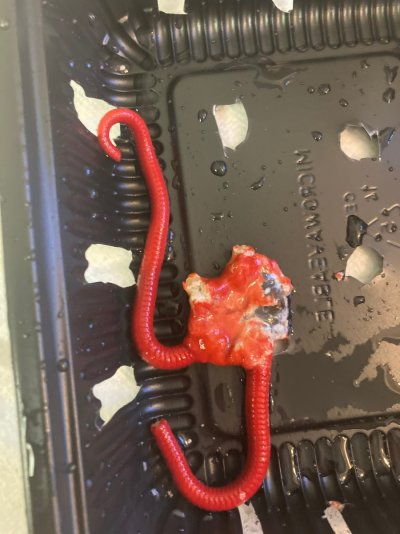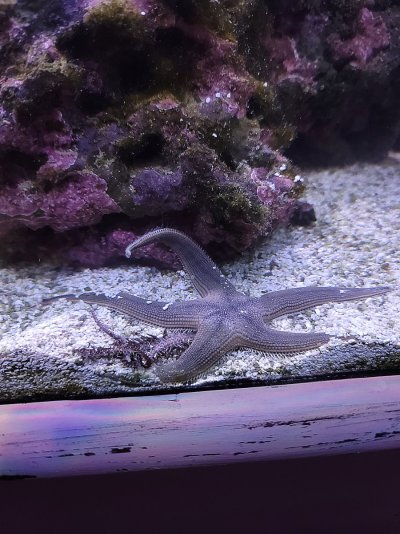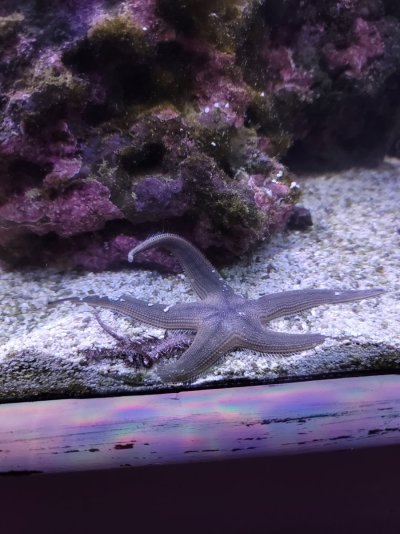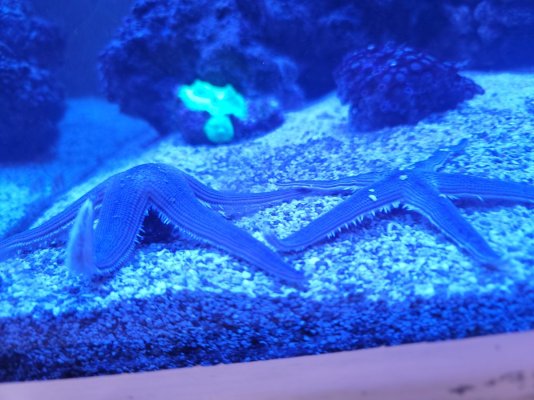Something is eating my star fish, don't have any idea what it is. Any thoughts on what it could be? It ate a orange serpent and Red fromia. I did see a couple of asterina in my tank, could they be the problem?
Navigation
Install the app
How to install the app on iOS
Follow along with the video below to see how to install our site as a web app on your home screen.

Note: This feature currently requires accessing the site using the built-in Safari browser.
More options
You are using an out of date browser. It may not display this or other websites correctly.
You should upgrade or use an alternative browser.
You should upgrade or use an alternative browser.
Orange serpent star
- Thread starter billpater
- Start date
- Joined
- Jun 9, 2021
- Messages
- 1,564
- Reaction score
- 1,542
- Review score
- +1 /0 /-0
- Location
- California USA
Not likely.Something is eating my star fish, don't have any idea what it is. Any thoughts on what it could be? It ate a orange serpent and Red fromia. I did see a couple of asterina in my tank, could they be the problem?
Any pictures?
What all else is in the tank?
- Joined
- Aug 29, 2020
- Messages
- 3,484
- Reaction score
- 3,492
- Review score
- +0 /0 /-0
- Location
- Central Texas
Are you sure they're being eaten, and not just starving? Fromias pretty much inevitably starve in all but the largest tanks. Brittle stars do much better, but still require supplemental feeding in most systems.
ISpeakForTheSeas
2500 Club Member
- Review score
- +0 /0 /-0
R2R Supporter
R2R Excellence Award
- Joined
- Nov 22, 2021
- Messages
- 3,058
- Reaction score
- 3,640
- Review score
- +0 /0 /-0
- Location
- United States
It's much more likely that your larger stars would eat the "Asterina" (Aquilonastra) stars than the other way around. As mentioned, your stars are probably starving to death.
No not starving, only have been in the tank three or four days, looks like something was eating the center of them and their legs. Could it be emerald crabs or hermit crabs?
- Joined
- Aug 29, 2020
- Messages
- 3,484
- Reaction score
- 3,492
- Review score
- +0 /0 /-0
- Location
- Central Texas
Not much eats starfish, though it does look chewed on. I wonder if it had a bacterial infection, or was dying already? They fall apart when dying.
ISpeakForTheSeas
2500 Club Member
- Review score
- +0 /0 /-0
R2R Supporter
R2R Excellence Award
- Joined
- Nov 22, 2021
- Messages
- 3,058
- Reaction score
- 3,640
- Review score
- +0 /0 /-0
- Location
- United States
I have to agree, that doesn’t look like the typical starfish/brittle star deaths that I’ve seen. As mentioned, not many things we keep in our tanks eat starfish/brittle stars, so while it’s possible the crabs/hermits may have eaten it, that seems extremely unlikely to me.
What all do you have in your tank fish- and inverts-wise?
What all do you have in your tank fish- and inverts-wise?
IKD
2500 Club Member
- Review score
- +2 /0 /-0
Partner Member 2023
Build Thread Contributor
- Joined
- Dec 13, 2015
- Messages
- 2,752
- Reaction score
- 4,111
- Review score
- +2 /0 /-0
- Location
- Orlando Area
What size tank do you have? Wonder if it was hit by a power head or something
Still very novice recently I had an issue. Had a brittle for 6 months and added 2 sand sifting stars. One of the sand sifters developed an appetite for snails and eventually ate my brittle. Nutrients bottomed out and he went savage.
Attachments
ISpeakForTheSeas
2500 Club Member
- Review score
- +0 /0 /-0
R2R Supporter
R2R Excellence Award
- Joined
- Nov 22, 2021
- Messages
- 3,058
- Reaction score
- 3,640
- Review score
- +0 /0 /-0
- Location
- United States
I have heard on very rare occasion of filefish attacking/eating starfish and brittle stars, so I suppose it’s possible it may be your culprit (that said, it doesn’t seem very likely from what I’ve seen, so if that’s your issue here, I’d be quite surprised):I have a file fish ,Red hawk clown fish, a couple of damsels, one brisle tooth tang, snow flake eel, a royal gramma, fire shrimp,dimond goby
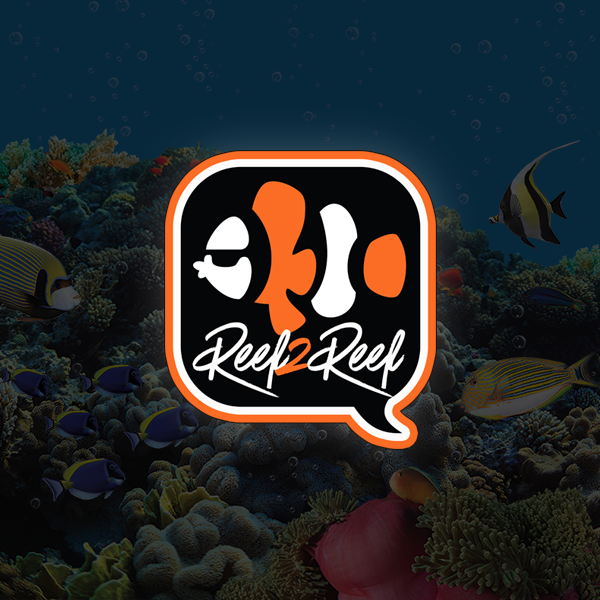
File fish
Anyone have experience with these guys in a reef? I have an aiptasia problem that I have been unable to take care of with aiptasia x. Thinking about trying one of these guys. I see that it says they are a shy fish and I have a couple tangs, a foxface, clowns and hopefully a group of anthias if...
 www.reef2reef.com
www.reef2reef.com

Aiptasia eating filefish, attacking starfish
. i bought an AIP-eating filefish, hes been in the tank since firday afternoon, ive just seen him following / hunting my bristle starfish is this normal for this type of fish scaff
 www.ultimatereef.net
www.ultimatereef.net

Filefish eating starfish?
Came downstairs to my mimic filefish eating a red starfish this morning? Is this expected? the thing is he wasn't actually nipping at it but it's like he was attached to it and just swaying in the flow, like he was sucking on it if you like
 www.ultimatereef.net
www.ultimatereef.net
ISpeakForTheSeas
2500 Club Member
- Review score
- +0 /0 /-0
R2R Supporter
R2R Excellence Award
- Joined
- Nov 22, 2021
- Messages
- 3,058
- Reaction score
- 3,640
- Review score
- +0 /0 /-0
- Location
- United States
Yeah, a lot of “sand-sifting starfish” species are actually predatory by nature, typically eating snails and/or bivalves (and sometimes other things too)Still very novice recently I had an issue. Had a brittle for 6 months and added 2 sand sifting stars. One of the sand sifters developed an appetite for snails and eventually ate my brittle. Nutrients bottomed out and he went savage.
The three genera I can recall at the moment that are commonly called sand sifters are Astropecten, Luidia (which isn’t common in the hobby, from what I’ve seen), and Archaster; of the three, Astropecten spp. and Luidia spp. are confirmed predators - Archaster spp. are supposedly detritivores, but that has (to my knowledge) never actually been studied/confirmed (including in the study other studies quoted to make that claim):
I’ve heard they climb the glass when they’re looking for food and can’t find any in the sand bed.
Generally, people recommend large tanks and waiting until your tank is established before trying these (or pretty much any) sea stars, and the star survives on detritus in the tank. Unfortunately, even in a lot of these tanks, after they finish clearing the detritus from the sand, they typically starve.
My current advice to avoid the star staving - which may or may not help, I genuinely don't know at this point (it could take someone months to years of testing it to find out for certain, as sea stars can last months without food):
Target feed the star things like clam on half shell, oyster, mussel, scallop, etc. (bivalves); snail, whelk, conch, etc. (sea snail gastropods); and a good quality omnivore food (like LRS Reef Frenzy or Fertility Frenzy). These are - according to the best sources of information I can find - the sorts of foods sand sifting stars consume in the wild, and the star should swallow these foods whole if they aren't too big - you might need to experiment a bit with the size of the pieces offered to get it sized just right, but generally I'd say err on the smaller side.
If you decide to give it a shot, let me know how it goes, and keep me updated on the long term survival of the star!
I'd try something like clam, oyster, etc. and/or snail meat (you can find various frozen/live marine snails to try online, including conch meat, periwinkle snails, babylonian snails, etc.)
The quote below is specifically geared toward Astropecten spp. (predatory) sand sifting stars, but there is another genus of sand sifting stars called Archaster that is thought (importantly the diet was inferred, not studied in the research that this diet was pulled from) to be detritivorous (specifically, they are thought to be microphagous detritivores). I have heard but cannot confirm that Archaster spp. misidentified as Astropecten spp. may be more common in the hobby than actual Astropecten spp. are.
So, with this in mind:
- If your star is detritivorous (which may be a very big if), then you would likely want smaller foods than the suggested below (which is designed for predatory sand sifters). In this case, I'd suggest trying to mix something like TDO Chroma Boost into the sand for your stars to find.
- If your star is predatory (which may to our limited knowledge be possible at this point even if it is an Archaster sp.), then the below advice (and my advice above) is more likely to be useful.
- If your star is actually primarily a biofilm eater like Linckia spp. Protoreaster nodosus, etc. (which may also to our limited knowledge be possible for an Archaster sp.), then it's likely to die regardless of what you do or don't feed it at this point.
Similar threads
- Replies
- 3
- Views
- 168
- Replies
- 11
- Views
- 237




